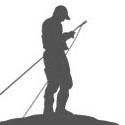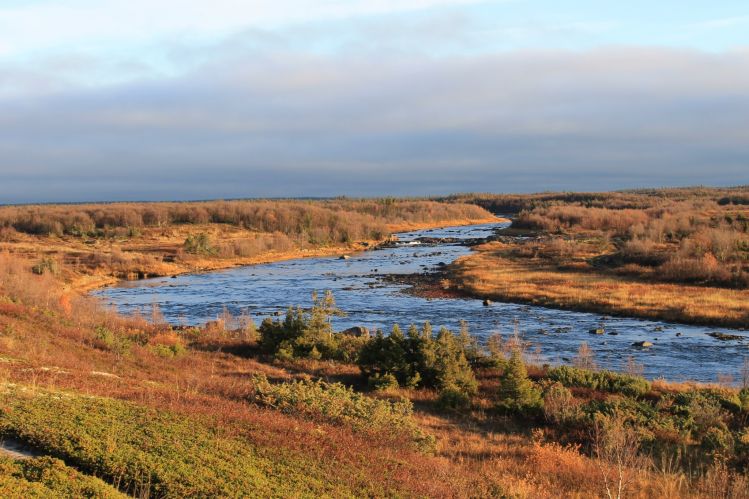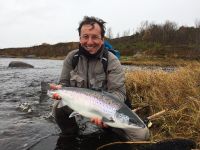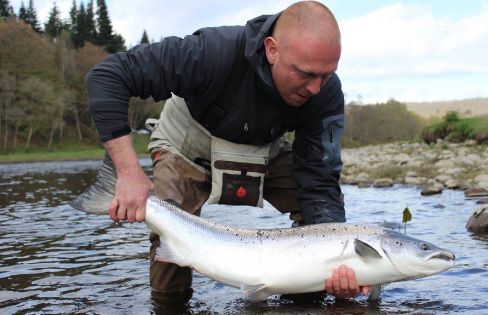The longer we fish for Atlantic salmon, more facts and experience accumulate in our heads but also more questions arise!
We try to use a long season on the Kola Peninsula to observe the behavior of the fish, and we also use the experience and results of every angler from our groups. Thus, we try to put together all the facts and opinions of many anglers. It is not simple.
As a rule, the experience and the result of fishing are extremely subjective. The opinion of one angler may not be 100% to coincide with the opinion of the other.
Nevertheless, the result of each fisherman allows you to create a more or less correct overall picture of what is happening on the river. You, too, have the right to be critical of my conclusions, since my reasoning concerns a specific time and a specific river. Although, I hope that the principles and approaches to assessing the situation are quite universal.
The questions asked by anglers are often arranged in this order:
1. The number of salmon in the river
2. Presence of fresh fish
3. State of water
4. Locations of salmon
5. Effective flies
6. Salmon activity
7. Fishing techniques
8. Tactical methods of fishing and tackle
9. Fly presentation
The first 2 - 3 questions usually have to be answered in the car on the way to the river. The remaining questions appear already on the river, depending on the individual results of fishing. Part of the fishermen quickly turn to the question of the fly. This, in my opinion, is not entirely correct, since an effective fly can only be discussed in connection with all the other factors. If you have the right answers to the 1,2,3,4,6,7,8, and 9 questions, then you can not even remember the fly. Its role is minimal.
This may sound paradoxical. But I will be glad if I can convince you of this.
We have only 2 relatively reliable signs of the presence of fish in the river.
The first sign is the jumping of salmon over the water or other activity at the surface that we can observe. The second sign of the presence of fish is bite on the fly.
It is clear that both these signs are very unreliable. Fish for various reasons may not show itself at the surface of the water. Most often, we associate the activity of salmon with the change in the water level, with the temperature and its dynamics. It should be taken into account that these changes have different effects on different fish. Some fish appeared in the river at the end of summer in August, other groups enter the river later, in early September or in October. Their adaptation to river water runs at different rates and affects their behavior in different ways. This refers to the movement of salmon in the river, rest areas or parking for a long time, and also affects the response to flies.
This year, for example, there was a period of high activity of fish that entered the river at the end of August. These fish are distinguished by a slight purple hue on the back. Such coloring occurs when salmon 2-3 weeks is in the river, the temperature of which is still quite high, about 9-12 degrees Celsius. It was possible to observe numerous jumps of such fish in places of their temporary parking, starting from the mouth of the river and far up the river. Usually salmon jumped on the border of pits or depressions in the main channel, which served as their temporary parking lot. After long rains in mid-September, the water level increased significantly + 30cm, and then the temperature dropped, which led to a sharp drop in the number of jumps. After a week, the temperature stabilized within 6-7 degrees C and the water level began to slowly decrease. Again we began to observe jumps of salmon with a purple hue of the body practically along all the length of the river. It is very difficult to estimate the number of fish in one pool. It can often be noticed that fish of different sizes jump, sometimes the fish only appears above the surface, sometimes it completely jumps out of the water in different directions and in different parts of the pool. It seems that the salmon do not tend to leave the pool, but only to demonstrate their presence here.
If you have time, sooner or later in each good pool you will see the fish. Sometimes it will be one jump, sometimes 5-6 per minute. Perhaps, this change in behavior depends even on the time of the day. If in the beginning of Autumn the position of the sun is important, then in October the change in daily temperature begins to play a greater role. Morning water temperature can be 1-1.5 degrees below daytime or evening. Therefore, the activity of fish on the surface is often observed in the evening. Surprisingly, such a slight temperature change affects fish life so much.
The approaching colds have a depressing effect on fish, which appeared in the river in August or early September. With the temperature drop in September from 12-10 degrees to 7-6 the part of this group of salmon loses activity. Large fish lose activity especially quickly, although small fish still show their presence.
By mid-September, the fresh salmon run usually becomes more active. If the water level in the river is sufficient, then the run of Atlantic salmon into the river can be quite intense. Usually fish come in small groups, in which there are also violet-colored individuals and completely silver. The colder the water, the less purple fish and more silver fish run into the river. Probably the most comfortable temperature of the water for silver fish is a temperature of 6 degrees C.
Fresh sea salmon can be distinguished by its silver color. The appearance and movement of these fish along the river is often associated with a high tide. They jump forward as if on the run. Such jumps are sometimes serial and you can trace the movement of a fish or an entire group upstream. A rising fish jumps over any obstacle that comes in its way. Most often these are small rifts or individual rocks blocking the main stream of the river.
We can`t know the exact number of such fresh fish in the river. Again we must take into account the water level and its temperature. Raising water level can hide the movement of fish, and lowering the temperature from comfortable 6-7 degrees to 2-3 could completely deprive the salmon move upstream. With a sharp cooling, which sometimes happens even in early October, the salmon simply stops in the deepest pits in the lowest parts of the river. Fish does not give out his presence until the onset of warming.
Fresh salmon, which moves upstream, often stops on the same stretches, which are already occupied by violet-colored fish. Arrival of new fish somehow stimulates the jumping of both local fish and new arrivals.
Such social behavior is quite typical for resident fish, which are preparing for spawning this fall. They also denote their presence by jumping. Resident fish, by early September accumulate in convenient shelters near future spawning grounds. Usually both male and female jump. These fish can be distinguished by dark brown color. Individuals ready to spawn are often painted completely black. Their jumping is of a slightly different nature than the jumping of the Autumn run fish. Most of the residents jump out of the water vertically and fall on the side. It is like jumping whales in the sea. With a decrease in the temperature of the water and the onset of spawning, more and more resident fish are run aground and jumps cease.
In early October, at a water temperature of 4-5-6 degrees, resident salmon stop jumping. They are shown on the surface at spawning grounds, if the water level allows one to see their backs and tails.
Here I would make a small digression. There is an opinion on the presence of spawning pits, the word pit is often tied to the salmon spawning place. The location of these pits or even one large or main spawning pit is supposed to be far upstream of the river. According to my observations, a significant number of salmons remain at the bottom of the river and spend unnoticed here all summer. They begin spawning at the first rifts only 400-500 meters from the mouth of the river. The true number of fish can be judged only when the water level in the spawning grounds allows them to be noticed. It's amazing how many large fish can be hidden from us in completely ordinary, unremarkable pools.
Other evidence of number of salmon in the river we can get already in the process of fishing. Still, most of the time we spend not observing jumping fish but in trying to catch it. We must take into account that counting fish bites is even more questionable way of estimating the numbers of fish than its jumps. But we have no other way, and sometimes it does happen that fishing gives a fairly correct answer.
Here you can underline 2 parts, one of which relates to our visual sensations and the other is sensitive or our hands. We can see the salmon's reaction to the fly or feel its bite.
Salmon in the state of rest is rarely noticeable, especially in deep pools or on the dark bottom. But the movement of the fish towards the fly sometimes gives it away. We usually do not notice movement of the fish to the surface or approaching the flies. Most often, we can see a trace on the surface in the form of a circle or a splash that indicates the turn of the fish from the fly. Whether the salmon took a fly or not, we can see a trace on the surface or a reflection of the body. Do not wait until the fish pulls the line. Considering that we do not feel significant part of the bites, pull the line as soon as we notice some movement. Like other fish, salmon quickly spits out all inedible objects. Even if it really visually liked your fly, in a second salmon will instinctively spit it out. Sometimes it looks like surface activity is not where our fly is and we pull he line just to check and surprisingly we hooked a fish. Its because we dont always know for sure where our fly is at exact moment of time.
It is interesting that the rise of salmon to the fly does not always depend on the depth. Of course, usually we notice the movement of the fish on the shallows. But quite often the fish rises to the fly from the depth of 1.5 - 2 or even 3 meters. Here the situation depends on the place, fish and the fly itself, especially its movement. We will talk about this later, but in any case it's very important to observe the place where exactly your fly is working.
I want to say that many anglers having difficulties or are not taught to notice such movements of salmon. And such a trace is a sign that it is an active fish and it can react to the fly again. We only need to repeat the cast and put the fly in the same place. Salmon can approach the fly or attempt to attack it several times in a row. Here, the main thing is to notice in time the signs of the fish, repeat the cast and try not to scare off the fish. We need to know exactly where the fish is and where our fly is. That is why it is necessary to control the position and movement of the fly.
In such cases it is better to reduce the casting distance and do not throw uncontrolled meters of line and nylon loops. When noticing salmon movement you can not make the same cast and same presentation of the fly, then something needs to be changed to your fishing techniques.
Sometimes we do everything correct and the fly is almost in the same place as last cast but salmon does not want to shift aside and take your fly. You can find an exact spot of last salmon bite by using a long strip over territory of where the fish is. Fly goes diagonally or against the current, you can lower the fly and hold up again. There are many options, some of them provoke salmon for a second attack. Of course, all these tricks are not needed if there is a stupid and aggressive fish in front of you.
In the next part below, let's talk about salmon attacks, and how it can indicate the amount of fish in the river.
Salmon bite is enough objective indication that there is salmon in the river. The more bites, the more fish in the river. Consequently, the smaller the number of bites, the less salmon in the water. Everything seems logical, but it only seems so.
Fresh example from the Chavanga River: one fisherman per week has 65 bites, 36 salmon caught. Another angler at the same time period has only 5 bites, 2 salmon are caught. Are there many fish in the river or not? Is it possible to use the logic of the bite / fish to answer unequivocally the question of the amount of salmon or the average catch?
In my opinion, one can not directly relate the number of bites to the number of fish, so it is impossible to answer these questions correctly. Objective evaluation is more dependent on the ability of the angler, especially on the ability to adapt his skills to specific fishing conditions.
Unfortunately, here again we will have to return to the basics, reasoning about how to read the river, how to take a better position and how to present the fly.
These 3 factors will help us to find the right tactics and techniques for fishing.
Briefly about what should be considered:
1. First we think about what natural factors affect the activity and behavior of fish: temperature, transparency and level of the water, their dynamics, time of day and illumination…..
2. Then we think about the possible position of the fish and choose the place of fishing: places for temporary rest or long parking, rapids or deep calm stretches…..
3. Now we are trying to determine the appropriate method of fishing (wet fly methods, streamer, nymphing or surface fishing) and with the appropriate tackle, casts….
4. We take the best position and apply casting for an effective fly presentation, correcting the direction, speed and level of the fly's movement
5. Now you can talk about a fly that is suitable for such a presentation, its size, color, weight and other properties that seem important to us.
Experience (positive or negative) often comes to us empirically, through trial and error. Evaluation of our knowledge and skills is given to us only through contact with salmon. Of course, much depends on the condition and intentions of the fish. On our part, the presentation of the fly determines what and how we will feel at the moment of contact with the fish and whether we will feel at all.
The principles of presentation / control over the fly when fishing salmon are no different from those when fishing other salmon species. In 90% of cases, we fish salmon by a method that is described as a wet fly method (we'll talk about the streamer and other methods separately). If you understand the principles of fishing trout or grayling on the wet fly, agree with me that these skills can be used when fishing salmon. Then the meaning of what I mean by the correct presentation and control of the fly will be understood. You can use all the known versions of classic or aggressive wet flies. They are, as a rule, quite effective in any conditions when fishing salmon. And salmon reaction is similar to the ones that we have when attacked by grayling and trout. It depends on factors 1-5, which we listed in previous article.
If you have a good control of the fly - you can feel all sort of interactions of salmon with the fly - from barely noticeable touch, to a sudden strike and breaking the line.
For example, when fishing on calm shallow waters with small wet flies, the salmon rises and gently takes the fly. We can notice the movement of fish under the water, splash on the surface or feel the light movement of the line. Salmon pull can be very delicate. The speed of movement of the fish aligns with the speed of the fly's drift, same thing happens when fishing grayling. If we manage to fill and pull the line, we often hook it by the nose. Same with any fish, regardless of whether it has just entered from the sea or is already ready for spawning.
But to link directly reaction of salmon with the size of a fly, its color or movement is very difficult. But there are some provocative moments you can notice that cause a nervous reaction of salmon.
Often the fly moves down to the right or to the left from where the salmon stay. Fish bite is felt in different ways, depending on which way the fish is moving - to us or from us. It is better if it turns around from us, then the line instantly stretches and we feel a strong pull. Power of the pull depends on what directions and what speed the fly and fish were moving at the time.
If salmon turns in our direction, the line is not stretched and the fish have a high chance to spit the fly out unnoticeably, until we feel the tension of the line. Even with a well-executed cast and proper control over the fly, we do not feel a large number of bites. If we miss the bite, the salmon spits out the hook and returns to the bottom. If salmon could not get rid of the hook, its running away pulling our line. So usually some time gone already before we feel the tension of the line, which we perceive as the moment of bite.
Therefore, it seems to me very doubtful the idea of keeping the loose loop of the line ready and not to hurry with hooking the fish. We don't know exactly how long the salmon is already swimming with our fly in its jaw. It is necessary to cut fast and clearly. What to do next - depends on the fish, your position in the water and so on.
The strongest strikes were observed when fishing passive salmon provoking it with a fly on the surface. For the first time, with this technique of salmon fishing i was introduced by my son George. This is also a method of wet fly fishing, its aggressive version. After the cast, George stopped the fly at the level of the supposed salmon position and pulled the line. The fly stopped and moved towards the surface forming a small wave. Now George does one or two strips against the current and the salmon impatiently jumps out of the hiding place to strike the fly on the surface. It's not so important in this situation which side salmon attacked from, what's important is that the line was stretched at the moment and salmon usually attacks such a surface fly with a move down afterwards. This is the most unpleasant situation for the angler if he presses the line with his right finger. If you have a loose line loop or not, automatically you will pull the line and the fish will have a chance to break a fishing line or tear out a piece its jaw.
Such a provoking fishing is very effective, and the position of the hook in the tongue or in the throat indicates an aggressive attack of the fish. You can cope with such a bite without delay and extra loose line. If you are aiming for the downstream bite of the fish, simply remove the finger and release the line. If the reel brake is in your normal state, then just pull the line, you will not break the line and you will not lose the fish.
But even in such a specific situation there could be many options. Last fall, we received a record number of false bites and a record number of salmon that fell off the hook. For each salmon we caught, there were 3-4 fish that we could not land. This is heavily depend on behavior of salmon, presentation of a fly and of course with landing skills. Personally, i can boast that I lost only 3 salmon in 2 months of fishing and had not more than a dozen fouls bites. At the same time, some anglers had 3-5 fouls bites per each fish caught and lost up to 25 fish per week. I already mentioned the importance of presentation and control over the fly in the diagnosis and implementation of bites.
Landing the fish is a separate topic and we will definitely talk about it later.
Hope you enjoyed this bit and we always happy to share some of our amazing moments on the river ;) Tight lines







